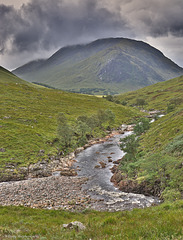
Rivers, streams, brooks, becks, even canals
Rowan by the River
| |
|
|
|
Taken on the Kilmarie to Camasunray track (Isle of Skye). A short linier walk of 2.5 m/8 km each way. The route rises to about 625 ft/190 mtrs (giving great views) before descending to sea level at the beach in Camasunray Bay.
River Etive
| |
|
|
|
The River Etive (Scottish Gaelic: Abhainn Èite) rises on the peaks surrounding Rannoch Moor, with several tributary streams coming together at the Kings House Hotel, at the head of Glen Coe. From the Kings House, the Etive flows through Glen Etive for about 11ml/18 km, reaching the sea at Loch Etive.
Window Reflections
| |
|
|
|
The water is that of the Kinness Burn as it flows into St. Andrews Harbour, Fife, Scotland
Kinness Burn- St. Andrews
| |
|
|
|
Kinness Burn reflections
| |
|
|
|
Weir on the Derwent at Kirkham Priory
| |
|
|
|
The ruins of Kirkham Priory are situated on the banks of the River Derwent, at Kirkham, North Yorkshire, England. The Augustinian priory was founded in the 1120s by Walter l'Espec, lord of nearby Helmsley, who also built Rievaulx Abbey.
A walk through Sawdon Dale (5 x PiPs)
| |
|
|
|
Sawdon Dale is a small, quite deep, steeply sided dale approximately 2.5 miles (4 km) in length. The dale follows the course of Sawdon Beck (small stream), south from high ground to the north of Sawdon village, to join Rushton Beck at the village of Rushton in the Vale of Pickering.
Weir - in sunshine and in shadow
| |
|
|
|
Low Mill Weir on the River Derwent, which forms the border between the villages of East and West Ayton, North Yorkshire.
Weir Overflow
| |
|
|
|
Low Mill Weir on the River Derwent, which forms the border between the villages of East and West Ayton, North Yorkshire.
Mill Lane cottages
Derwent in the shade - Forge Valley - (1 x PiP)
| |
|
|
|
Yorkshire River Derwent
The Yorkshire Derwent rises at Lilla Rigg on Fylingdales Moor (North York Moors) the only river of the eastern moors, running south east across the moors towards the coast.
The river changes in character more than most moorland rivers. The upper reaches flow between the northern end of Langdale Forest and the open moors. After four miles the river turns south and runs through Langdale (a valley), with the narrow ridge of Langdale Rigg to the west and the steep slopes of Broxa Forest to the east.
After emerging from Langdale the Derwent meanders its way through an area of more open farmland, bounded by steep sided but more distant hills. Originally this was the last stretch of the river, and it ran into the sea just to the north of Scarborough.
This all changed during the last ice age, towards the end of which the glaciers retreated at different speeds, with the thinner glaciers over the Moors melting more quickly than those over the modern North Sea. As a result the Derwent was unable to flow into the sea and a large lake built up to the north of the Tabular Hills. Eventually this lake overflowed the hills penning it in. The resulting flood carved out Forge Valley.
The Derwent still flows down the Forge Valley, emerging form the moors between West and East Ayton. At this point the river is only four miles from the coast, but it turns its back to the sea and flows west across the Vale of Pickering. The total length of the Derwent is approximately 71 miles (113km). It joins the River Ouse near Barmby on Marsh in East Yorkshire.
The name was recorded by Bede in the 8th century as Deruuentionis fluvii , from the Celtic “river where oak trees grow abundantly".
Horse Chestnut shading the Derwent
| |
|
|
|
Down by the Derwent - (Spot the Heron)
The road, the fence, and the river (HFF everyone)
| |
|
|
|
The road is Seavegate, which runs through Forge Valley for approximately 2.5km, alongside the River Derwent. At the top of the hill the road enters East Ayton and becomes Castlegate.
A little sunlight at last
Crocus carpet by the Derwent
Jump to top
RSS feed- Latest items - Subscribe to the latest items added to this album
- ipernity © 2007-2025
- Help & Contact
|
Club news
|
About ipernity
|
History |
ipernity Club & Prices |
Guide of good conduct
Donate | Group guidelines | Privacy policy | Terms of use | Statutes | In memoria -
Facebook
Twitter
















